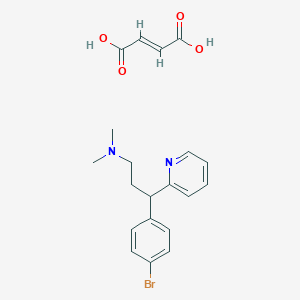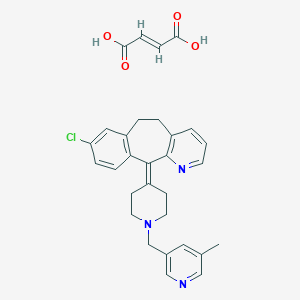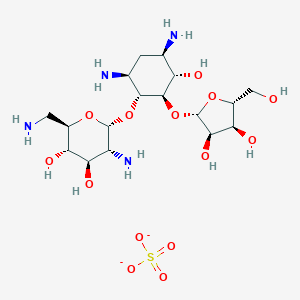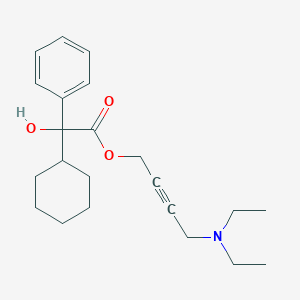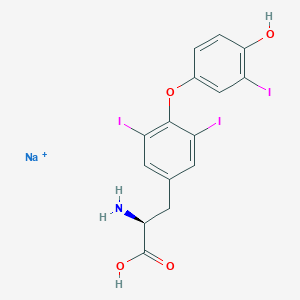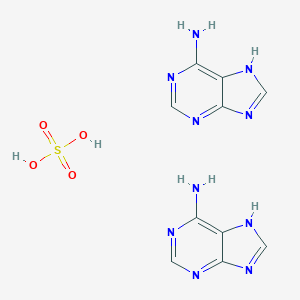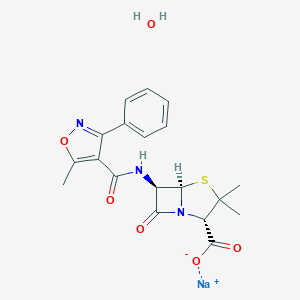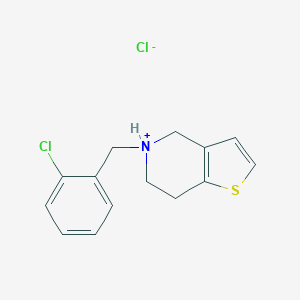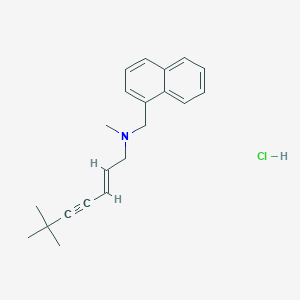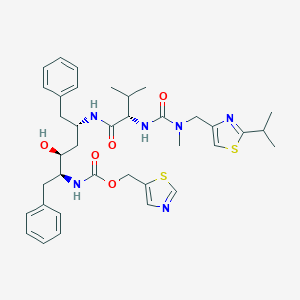
Ritonavir
Vue d'ensemble
Description
Ritonavir is an antiretroviral medication primarily used in combination with other medications to treat HIV/AIDS. It belongs to the class of protease inhibitors and is marketed under the brand name Norvir . This compound was initially developed as an independent antiviral agent but is now more commonly used to boost the potency of other protease inhibitors by inhibiting the enzyme that metabolizes them .
Mécanisme D'action
Target of Action
Ritonavir is primarily an HIV protease inhibitor . It interferes with the reproductive cycle of HIV by inhibiting the HIV-1 protease, a protein vital for the virus’s life cycle . This protease is responsible for cleaving the viral Gag-Pol polyprotein precursors into individual functional proteins required for the formation of infectious HIV .
Mode of Action
This compound binds to the site of HIV-1 protease activity and inhibits the cleavage of viral Gag-Pol polyprotein precursors . This inhibition prevents the formation of mature, infectious viral particles, resulting in the release of immature, noninfectious viral particles .
Biochemical Pathways
This compound is a potent inhibitor of the cytochrome P450 3A4 (CYP3A4) enzyme . This enzyme is responsible for the metabolism of many drugs. By inhibiting CYP3A4, this compound reduces the metabolism of concomitantly administered protease inhibitors, thereby increasing their bioavailability .
Pharmacokinetics
This compound is primarily metabolized by cytochrome P450 (CYP) 3A isozymes and, to a lesser extent, by CYP2D6 . It exhibits relatively linear pharmacokinetics after multiple doses, with an apparent oral clearance averaging 7 to 9 L/h . This compound is approximately 98 to 99% bound to plasma proteins . About 34% and 3.5% of a 600mg dose is excreted as unchanged drug in the feces and urine, respectively . The clinically relevant half-life is about 3 to 5 hours .
Result of Action
The primary result of this compound’s action is the formation of immature, noninfectious viral particles . By inhibiting the HIV-1 protease, this compound prevents the maturation of the virus, thereby reducing the number of infectious particles released from infected cells .
Action Environment
Environmental factors can influence the action, efficacy, and stability of this compound. For instance, the presence of other drugs metabolized by the CYP3A4 enzyme can affect this compound’s efficacy due to potential drug-drug interactions . Additionally, this compound shows the highest chronic toxicity to aquatic organisms, indicating that environmental exposure could potentially influence its action .
Applications De Recherche Scientifique
Ritonavir has a wide range of scientific research applications:
Chemistry: Used as a model compound to study protease inhibition and enzyme kinetics.
Biology: Employed in research on viral replication and resistance mechanisms.
Medicine: Integral in the development of combination therapies for HIV/AIDS and hepatitis C.
Industry: Utilized in the formulation of pharmaceutical products and in the study of drug-drug interactions.
Analyse Biochimique
Biochemical Properties
Ritonavir interacts with various enzymes and proteins. It inhibits the cytochrome P450 (CYP) 3A4 enzyme, which reduces the metabolism of concomitantly administered protease inhibitors . This interaction changes the pharmacokinetic parameters of the other protease inhibitors, including their area under the curve (AUC), maximum concentration (Cmax), minimum concentration (Cmin), and half-life (t1/2), thereby increasing their bioavailability .
Cellular Effects
This compound has significant effects on various types of cells and cellular processes. For instance, it triggers endoplasmic reticulum stress, leading to mitochondria-mediated apoptosis in cells treated with this protease inhibitor . It also plays a role in limiting cellular transport and efflux of other protease inhibitors via the P-glycoprotein and MRP efflux channels .
Molecular Mechanism
This compound exerts its effects at the molecular level through several mechanisms. It binds directly to the active site of the main protease, thus stopping viral replication by blocking the processing of the polyprotein precursors . It also inhibits the cytochrome P450 3A4 enzyme, which reduces the metabolism of concomitantly administered protease inhibitors .
Temporal Effects in Laboratory Settings
In laboratory settings, this compound’s effects change over time. For instance, even during chronic this compound administration, its potent CYP3A inhibitory effect appears to predominate
Dosage Effects in Animal Models
In animal models, the effects of this compound vary with different dosages. For example, female ferrets dosed with 20 or 100 mg/kg nirmatrelvir/ritonavir twice-daily show a 1–2 log order reduction of viral RNA copies and infectious titers .
Metabolic Pathways
This compound is involved in various metabolic pathways. It inhibits the cytochrome P450 3A4 enzyme, which reduces the metabolism of concomitantly administered protease inhibitors . This inhibition allows unbound nirmatrelvir trough concentration to exceed the antiviral in vitro 90% effective concentration throughout the dosing period .
Transport and Distribution
This compound is transported and distributed within cells and tissues. It is known to limit cellular transport and efflux of other protease inhibitors via the P-glycoprotein and MRP efflux channels
Subcellular Localization
It is known that this compound may limit cellular transport and efflux of other protease inhibitors via the P-glycoprotein and MRP efflux channels .
Méthodes De Préparation
Synthetic Routes and Reaction Conditions: Ritonavir is synthesized through a multi-step process involving several key intermediates. The synthesis begins with the preparation of the thiazole ring, followed by the coupling of this ring with a protected amino acid derivative. Subsequent steps involve the formation of the hydroxyethylamine core and the final coupling with a carbamate derivative .
Industrial Production Methods: Industrial production of this compound involves optimizing the synthetic route to ensure high yield and purity. This includes the use of high-performance liquid chromatography (HPLC) for purification and the application of robust reaction conditions to minimize impurities .
Analyse Des Réactions Chimiques
Types of Reactions: Ritonavir undergoes several types of chemical reactions, including oxidation, reduction, and substitution.
Common Reagents and Conditions:
Oxidation: Common oxidizing agents such as hydrogen peroxide and potassium permanganate are used.
Reduction: Reducing agents like sodium borohydride are employed.
Substitution: Nucleophilic substitution reactions are facilitated using reagents like sodium hydroxide.
Major Products: The major products formed from these reactions include various oxidized and reduced derivatives of this compound, which are often analyzed to understand the drug’s stability and metabolism .
Comparaison Avec Des Composés Similaires
Lopinavir: Another protease inhibitor often used in combination with ritonavir.
Saquinavir: A protease inhibitor with a similar mechanism of action.
Indinavir: Known for its use in combination therapies for HIV/AIDS.
Uniqueness: this compound’s unique ability to inhibit CYP3A4 makes it an essential component in boosting the efficacy of other protease inhibitors. This property distinguishes it from other protease inhibitors that do not have the same level of enzyme inhibition .
Propriétés
IUPAC Name |
1,3-thiazol-5-ylmethyl N-[(2S,3S,5S)-3-hydroxy-5-[[(2S)-3-methyl-2-[[methyl-[(2-propan-2-yl-1,3-thiazol-4-yl)methyl]carbamoyl]amino]butanoyl]amino]-1,6-diphenylhexan-2-yl]carbamate | |
|---|---|---|
| Source | PubChem | |
| URL | https://pubchem.ncbi.nlm.nih.gov | |
| Description | Data deposited in or computed by PubChem | |
InChI |
InChI=1S/C37H48N6O5S2/c1-24(2)33(42-36(46)43(5)20-29-22-49-35(40-29)25(3)4)34(45)39-28(16-26-12-8-6-9-13-26)18-32(44)31(17-27-14-10-7-11-15-27)41-37(47)48-21-30-19-38-23-50-30/h6-15,19,22-25,28,31-33,44H,16-18,20-21H2,1-5H3,(H,39,45)(H,41,47)(H,42,46)/t28-,31-,32-,33-/m0/s1 | |
| Source | PubChem | |
| URL | https://pubchem.ncbi.nlm.nih.gov | |
| Description | Data deposited in or computed by PubChem | |
InChI Key |
NCDNCNXCDXHOMX-XGKFQTDJSA-N | |
| Source | PubChem | |
| URL | https://pubchem.ncbi.nlm.nih.gov | |
| Description | Data deposited in or computed by PubChem | |
Canonical SMILES |
CC(C)C1=NC(=CS1)CN(C)C(=O)NC(C(C)C)C(=O)NC(CC2=CC=CC=C2)CC(C(CC3=CC=CC=C3)NC(=O)OCC4=CN=CS4)O | |
| Source | PubChem | |
| URL | https://pubchem.ncbi.nlm.nih.gov | |
| Description | Data deposited in or computed by PubChem | |
Isomeric SMILES |
CC(C)C1=NC(=CS1)CN(C)C(=O)N[C@@H](C(C)C)C(=O)N[C@@H](CC2=CC=CC=C2)C[C@@H]([C@H](CC3=CC=CC=C3)NC(=O)OCC4=CN=CS4)O | |
| Source | PubChem | |
| URL | https://pubchem.ncbi.nlm.nih.gov | |
| Description | Data deposited in or computed by PubChem | |
Molecular Formula |
C37H48N6O5S2 | |
| Source | PubChem | |
| URL | https://pubchem.ncbi.nlm.nih.gov | |
| Description | Data deposited in or computed by PubChem | |
DSSTOX Substance ID |
DTXSID1048627 | |
| Record name | Ritonavir | |
| Source | EPA DSSTox | |
| URL | https://comptox.epa.gov/dashboard/DTXSID1048627 | |
| Description | DSSTox provides a high quality public chemistry resource for supporting improved predictive toxicology. | |
Molecular Weight |
720.9 g/mol | |
| Source | PubChem | |
| URL | https://pubchem.ncbi.nlm.nih.gov | |
| Description | Data deposited in or computed by PubChem | |
Physical Description |
Solid | |
| Record name | Ritonavir | |
| Source | Human Metabolome Database (HMDB) | |
| URL | http://www.hmdb.ca/metabolites/HMDB0014646 | |
| Description | The Human Metabolome Database (HMDB) is a freely available electronic database containing detailed information about small molecule metabolites found in the human body. | |
| Explanation | HMDB is offered to the public as a freely available resource. Use and re-distribution of the data, in whole or in part, for commercial purposes requires explicit permission of the authors and explicit acknowledgment of the source material (HMDB) and the original publication (see the HMDB citing page). We ask that users who download significant portions of the database cite the HMDB paper in any resulting publications. | |
Solubility |
Practically insoluble, Freely soluble in methanol and ethanol; soluble in isopropanol., In water, 1.1X10-4 mg/L @ 25 °C /Estimated/, 1.26e-03 g/L | |
| Record name | Ritonavir | |
| Source | DrugBank | |
| URL | https://www.drugbank.ca/drugs/DB00503 | |
| Description | The DrugBank database is a unique bioinformatics and cheminformatics resource that combines detailed drug (i.e. chemical, pharmacological and pharmaceutical) data with comprehensive drug target (i.e. sequence, structure, and pathway) information. | |
| Explanation | Creative Common's Attribution-NonCommercial 4.0 International License (http://creativecommons.org/licenses/by-nc/4.0/legalcode) | |
| Record name | RITONAVIR | |
| Source | Hazardous Substances Data Bank (HSDB) | |
| URL | https://pubchem.ncbi.nlm.nih.gov/source/hsdb/7160 | |
| Description | The Hazardous Substances Data Bank (HSDB) is a toxicology database that focuses on the toxicology of potentially hazardous chemicals. It provides information on human exposure, industrial hygiene, emergency handling procedures, environmental fate, regulatory requirements, nanomaterials, and related areas. The information in HSDB has been assessed by a Scientific Review Panel. | |
| Record name | Ritonavir | |
| Source | Human Metabolome Database (HMDB) | |
| URL | http://www.hmdb.ca/metabolites/HMDB0014646 | |
| Description | The Human Metabolome Database (HMDB) is a freely available electronic database containing detailed information about small molecule metabolites found in the human body. | |
| Explanation | HMDB is offered to the public as a freely available resource. Use and re-distribution of the data, in whole or in part, for commercial purposes requires explicit permission of the authors and explicit acknowledgment of the source material (HMDB) and the original publication (see the HMDB citing page). We ask that users who download significant portions of the database cite the HMDB paper in any resulting publications. | |
Vapor Pressure |
1.1X10-27 mm Hg @ 25 °C /Estimated/ | |
| Record name | RITONAVIR | |
| Source | Hazardous Substances Data Bank (HSDB) | |
| URL | https://pubchem.ncbi.nlm.nih.gov/source/hsdb/7160 | |
| Description | The Hazardous Substances Data Bank (HSDB) is a toxicology database that focuses on the toxicology of potentially hazardous chemicals. It provides information on human exposure, industrial hygiene, emergency handling procedures, environmental fate, regulatory requirements, nanomaterials, and related areas. The information in HSDB has been assessed by a Scientific Review Panel. | |
Mechanism of Action |
Ritonavic inhibits the HIV viral proteinase enzyme that normally cleaves the structural and replicative proteins that arise from major HIV genes, such as *gag* and *pol*. *Gag* encodes proteins involved in the core and the nucleocapsid, while *pol* encodes the the HIV reverse transcriptase, ribonuclease H, integrase, and protease. The *pol*-encoded proteins are initially translated in the form of a larger precursoe polypeptide, *gag-pol*, and needs to be cleaved by HIV protease to form other complement proteins. Ritonavir prevents the cleavage of the *gag-pol* polyprotein, which results in noninfectious, immature viral particles. Ritonavir is a potent inhibitor of cytochrome P450 CYP3A4 isoenzyme present both in the intestinal tract and liver. It is a type II ligand that perfectly fits into the CYP3A4 active site cavity and irreversibly binds to the heme iron via the thiazole nitrogen, which decreases the redox potential of the protein and precludes its reduction with the redox partner, cytochrome P450 reductase. Ritonavir may also play a role in limiting cellular transport and efflux of other protease inhibitors via the P-glycoprotein and MRP efflux channels., Unlike nucleoside antiretroviral agents, the antiviral activity of ritonavir does not depend on intracellular conversion to an active metabolite. Ritonavir and other HIV protease inhibitors (e.g., amprenavir, indinavir, lopinavir, nelfinavir, saquinavir) act at a different stage of the HIV replication cycle than nucleoside and nonnucleoside reverse transcriptase inhibitors, and results of in vitro studies indicate that the antiretroviral effects of HIV protease inhibitors and some nucleoside or nonnucleoside antiretroviral agents may be additive or synergistic., Ritonavir is a selective, competitive, reversible inhibitor of HIV protease. HIV protease, an aspartic endopeptidase that functions as a homodimer, plays an essential role in the HIV replication cycle and the formation of infectious virus. During HIV replication, HIV protease cleaves viral polypeptide products of the gag and gag-pol genes (i.e., p55 and p160) to form structural proteins of the virion core (i.e., p17, p24, p9, and p7) and essential viral enzymes (i.e., reverse transcriptase, integrase, and protease). By interfering with the formation of these essential proteins and enzymes, ritonavir blocks maturation of the virus and causes formation of nonfunctional, immature, noninfectious virions. Ritonavir is active in both acutely and chronically infected cells since it targets the HIV replication cycle after translation and before assembly. Thus, the drug is active in chronically infected cells (e.g., monocytes and macrophages) that generally are not affected by nucleoside reverse transcriptase inhibitors (e.g., didanosine, lamivudine, stavudine, zalcitabine, zidovudine). Ritonavir does not affect early stages of the HIV replication cycle; however, the drug interferes with production of infectious HIV and limits further infectious spread of the virus., While the complete mechanisms of antiviral activity of ritonavir have not been fully elucidated, ritonavir apparently inhibits replication of retroviruses, including human immunodeficiency virus type 1 (HIV-1) and 2 (HIV-2), by interfering with HIV protease. The drug, therefore, exerts a virustatic effect against retroviruses by acting as an HIV protease inhibitor. | |
| Record name | Ritonavir | |
| Source | DrugBank | |
| URL | https://www.drugbank.ca/drugs/DB00503 | |
| Description | The DrugBank database is a unique bioinformatics and cheminformatics resource that combines detailed drug (i.e. chemical, pharmacological and pharmaceutical) data with comprehensive drug target (i.e. sequence, structure, and pathway) information. | |
| Explanation | Creative Common's Attribution-NonCommercial 4.0 International License (http://creativecommons.org/licenses/by-nc/4.0/legalcode) | |
| Record name | RITONAVIR | |
| Source | Hazardous Substances Data Bank (HSDB) | |
| URL | https://pubchem.ncbi.nlm.nih.gov/source/hsdb/7160 | |
| Description | The Hazardous Substances Data Bank (HSDB) is a toxicology database that focuses on the toxicology of potentially hazardous chemicals. It provides information on human exposure, industrial hygiene, emergency handling procedures, environmental fate, regulatory requirements, nanomaterials, and related areas. The information in HSDB has been assessed by a Scientific Review Panel. | |
Color/Form |
White to light tan powder | |
CAS No. |
155213-67-5 | |
| Record name | Ritonavir | |
| Source | CAS Common Chemistry | |
| URL | https://commonchemistry.cas.org/detail?cas_rn=155213-67-5 | |
| Description | CAS Common Chemistry is an open community resource for accessing chemical information. Nearly 500,000 chemical substances from CAS REGISTRY cover areas of community interest, including common and frequently regulated chemicals, and those relevant to high school and undergraduate chemistry classes. This chemical information, curated by our expert scientists, is provided in alignment with our mission as a division of the American Chemical Society. | |
| Explanation | The data from CAS Common Chemistry is provided under a CC-BY-NC 4.0 license, unless otherwise stated. | |
| Record name | Ritonavir [USAN:USP:INN:BAN] | |
| Source | ChemIDplus | |
| URL | https://pubchem.ncbi.nlm.nih.gov/substance/?source=chemidplus&sourceid=0155213675 | |
| Description | ChemIDplus is a free, web search system that provides access to the structure and nomenclature authority files used for the identification of chemical substances cited in National Library of Medicine (NLM) databases, including the TOXNET system. | |
| Record name | Ritonavir | |
| Source | DrugBank | |
| URL | https://www.drugbank.ca/drugs/DB00503 | |
| Description | The DrugBank database is a unique bioinformatics and cheminformatics resource that combines detailed drug (i.e. chemical, pharmacological and pharmaceutical) data with comprehensive drug target (i.e. sequence, structure, and pathway) information. | |
| Explanation | Creative Common's Attribution-NonCommercial 4.0 International License (http://creativecommons.org/licenses/by-nc/4.0/legalcode) | |
| Record name | ritonavir | |
| Source | DTP/NCI | |
| URL | https://dtp.cancer.gov/dtpstandard/servlet/dwindex?searchtype=NSC&outputformat=html&searchlist=760369 | |
| Description | The NCI Development Therapeutics Program (DTP) provides services and resources to the academic and private-sector research communities worldwide to facilitate the discovery and development of new cancer therapeutic agents. | |
| Explanation | Unless otherwise indicated, all text within NCI products is free of copyright and may be reused without our permission. Credit the National Cancer Institute as the source. | |
| Record name | ritonavir | |
| Source | DTP/NCI | |
| URL | https://dtp.cancer.gov/dtpstandard/servlet/dwindex?searchtype=NSC&outputformat=html&searchlist=693184 | |
| Description | The NCI Development Therapeutics Program (DTP) provides services and resources to the academic and private-sector research communities worldwide to facilitate the discovery and development of new cancer therapeutic agents. | |
| Explanation | Unless otherwise indicated, all text within NCI products is free of copyright and may be reused without our permission. Credit the National Cancer Institute as the source. | |
| Record name | Ritonavir | |
| Source | EPA DSSTox | |
| URL | https://comptox.epa.gov/dashboard/DTXSID1048627 | |
| Description | DSSTox provides a high quality public chemistry resource for supporting improved predictive toxicology. | |
| Record name | RITONAVIR | |
| Source | FDA Global Substance Registration System (GSRS) | |
| URL | https://gsrs.ncats.nih.gov/ginas/app/beta/substances/O3J8G9O825 | |
| Description | The FDA Global Substance Registration System (GSRS) enables the efficient and accurate exchange of information on what substances are in regulated products. Instead of relying on names, which vary across regulatory domains, countries, and regions, the GSRS knowledge base makes it possible for substances to be defined by standardized, scientific descriptions. | |
| Explanation | Unless otherwise noted, the contents of the FDA website (www.fda.gov), both text and graphics, are not copyrighted. They are in the public domain and may be republished, reprinted and otherwise used freely by anyone without the need to obtain permission from FDA. Credit to the U.S. Food and Drug Administration as the source is appreciated but not required. | |
| Record name | RITONAVIR | |
| Source | Hazardous Substances Data Bank (HSDB) | |
| URL | https://pubchem.ncbi.nlm.nih.gov/source/hsdb/7160 | |
| Description | The Hazardous Substances Data Bank (HSDB) is a toxicology database that focuses on the toxicology of potentially hazardous chemicals. It provides information on human exposure, industrial hygiene, emergency handling procedures, environmental fate, regulatory requirements, nanomaterials, and related areas. The information in HSDB has been assessed by a Scientific Review Panel. | |
| Record name | Ritonavir | |
| Source | Human Metabolome Database (HMDB) | |
| URL | http://www.hmdb.ca/metabolites/HMDB0014646 | |
| Description | The Human Metabolome Database (HMDB) is a freely available electronic database containing detailed information about small molecule metabolites found in the human body. | |
| Explanation | HMDB is offered to the public as a freely available resource. Use and re-distribution of the data, in whole or in part, for commercial purposes requires explicit permission of the authors and explicit acknowledgment of the source material (HMDB) and the original publication (see the HMDB citing page). We ask that users who download significant portions of the database cite the HMDB paper in any resulting publications. | |
Retrosynthesis Analysis
AI-Powered Synthesis Planning: Our tool employs the Template_relevance Pistachio, Template_relevance Bkms_metabolic, Template_relevance Pistachio_ringbreaker, Template_relevance Reaxys, Template_relevance Reaxys_biocatalysis model, leveraging a vast database of chemical reactions to predict feasible synthetic routes.
One-Step Synthesis Focus: Specifically designed for one-step synthesis, it provides concise and direct routes for your target compounds, streamlining the synthesis process.
Accurate Predictions: Utilizing the extensive PISTACHIO, BKMS_METABOLIC, PISTACHIO_RINGBREAKER, REAXYS, REAXYS_BIOCATALYSIS database, our tool offers high-accuracy predictions, reflecting the latest in chemical research and data.
Strategy Settings
| Precursor scoring | Relevance Heuristic |
|---|---|
| Min. plausibility | 0.01 |
| Model | Template_relevance |
| Template Set | Pistachio/Bkms_metabolic/Pistachio_ringbreaker/Reaxys/Reaxys_biocatalysis |
| Top-N result to add to graph | 6 |
Feasible Synthetic Routes
Q1: What is the primary mechanism of action of Ritonavir?
A1: this compound is a potent inhibitor of the human immunodeficiency virus type 1 (HIV-1) protease []. This enzyme is crucial for the viral life cycle, specifically for the cleavage of viral polyprotein precursors into individual functional proteins necessary for viral assembly and infectivity [].
Q2: What are the downstream effects of this compound inhibiting HIV-1 protease?
A2: By inhibiting HIV-1 protease, this compound prevents the cleavage of viral polyproteins. This disruption results in the production of immature, non-infectious viral particles []. Consequently, viral replication is inhibited, leading to a decrease in viral load within the infected individual [].
Q3: What is the molecular formula and weight of this compound?
A3: The molecular formula of this compound is C37H48N6O5S2, and its molecular weight is 720.95 g/mol [].
Q4: Is there spectroscopic data available for this compound?
A4: While the provided research papers don’t delve into detailed spectroscopic characterization, several analytical methods are mentioned. These include high-performance liquid chromatography (HPLC) often coupled with tandem mass spectrometry (HPLC/MS) for the quantification of this compound in biological matrices [, ].
Q5: How is this compound absorbed and metabolized in the body?
A5: this compound exhibits variable oral bioavailability due to its poor aqueous solubility [, ]. It undergoes extensive first-pass metabolism, primarily by cytochrome P450 (CYP) enzymes, particularly CYP3A4, in the liver and intestines [, ].
Q6: Are there any specific drug interactions with this compound that clinicians should be aware of?
A7: Numerous drug-drug interactions with this compound have been documented. For example, this compound significantly reduces the systemic exposure of gemfibrozil [], and co-administration with omeprazole decreases atazanavir exposure []. Careful consideration of potential interactions is crucial when prescribing this compound, and dose adjustments may be necessary.
Q7: Does this compound induce the activity of any drug-metabolizing enzymes?
A8: Interestingly, despite being a potent CYP3A4 inhibitor, this compound has been shown to induce the activity of CYP2B6 []. This induction is rapid, occurring after just three days of this compound administration, and persists for a minimum of two weeks []. This dual nature of this compound as both an inducer and inhibitor of drug-metabolizing enzymes highlights the complexity of its pharmacokinetic profile.
Q8: What are the implications of this compound inducing CYP2B6 activity?
A9: The induction of CYP2B6 by this compound can have significant clinical implications, particularly regarding drug interactions []. It may explain previously unexplained interactions and necessitate dose adjustments for drugs metabolized by CYP2B6.
A10: Yes, HIV can develop resistance to this compound, primarily through mutations in the HIV protease gene [, , ]. These mutations can reduce this compound's ability to bind to and inhibit the protease enzyme.
Q9: Is there cross-resistance between this compound and other HIV protease inhibitors?
A11: Yes, cross-resistance can occur between this compound and other protease inhibitors. For example, patients failing indinavir or this compound therapy may develop resistance to a subsequent regimen containing this compound and saquinavir due to the presence of mutations associated with resistance to this compound/saquinavir monotherapy [].
Q10: How does the emergence of drug resistance impact the clinical use of this compound?
A12: The development of resistance necessitates the use of combination antiretroviral therapy, including this compound, to suppress viral replication effectively and prevent the emergence of resistant viral strains [, , ]. Genotypic resistance testing is a valuable tool to guide treatment decisions and optimize therapy for patients failing this compound-containing regimens [, ].
Avertissement et informations sur les produits de recherche in vitro
Veuillez noter que tous les articles et informations sur les produits présentés sur BenchChem sont destinés uniquement à des fins informatives. Les produits disponibles à l'achat sur BenchChem sont spécifiquement conçus pour des études in vitro, qui sont réalisées en dehors des organismes vivants. Les études in vitro, dérivées du terme latin "in verre", impliquent des expériences réalisées dans des environnements de laboratoire contrôlés à l'aide de cellules ou de tissus. Il est important de noter que ces produits ne sont pas classés comme médicaments et n'ont pas reçu l'approbation de la FDA pour la prévention, le traitement ou la guérison de toute condition médicale, affection ou maladie. Nous devons souligner que toute forme d'introduction corporelle de ces produits chez les humains ou les animaux est strictement interdite par la loi. Il est essentiel de respecter ces directives pour assurer la conformité aux normes légales et éthiques en matière de recherche et d'expérimentation.



